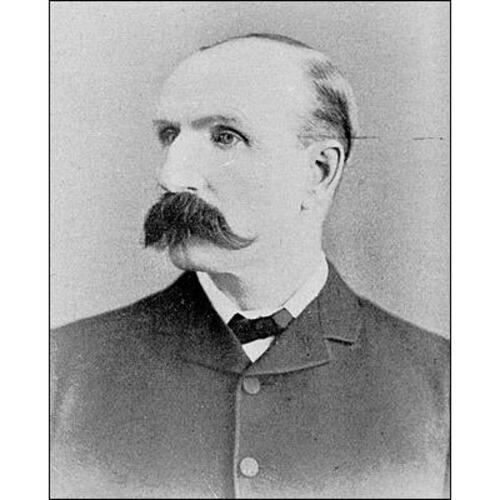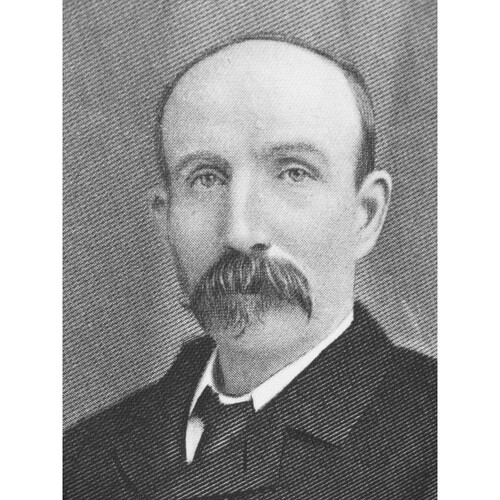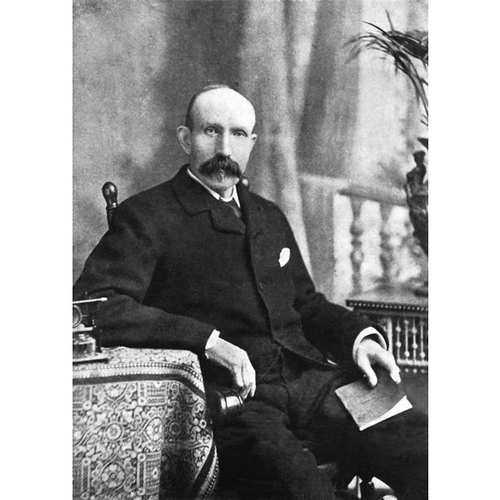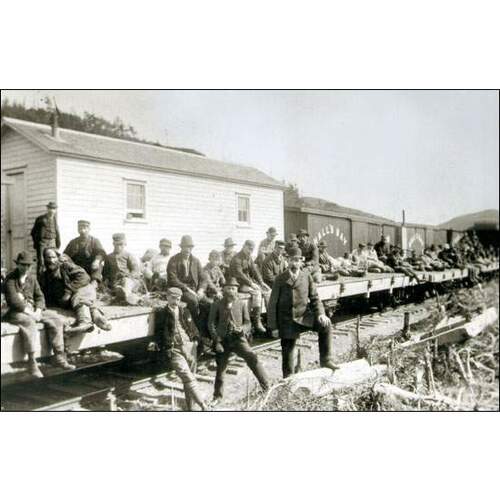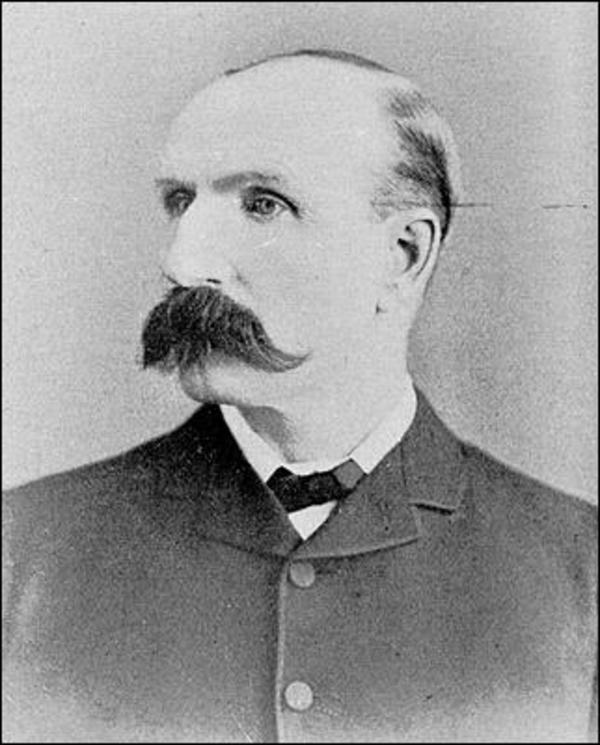
Source: Link
REID, Sir ROBERT GILLESPIE, railway contractor; b. 12 Oct. 1842 in Coupar Angus, Scotland, son of William Robertson Reid and Catherine Gillespie; m. 17 Aug. 1865 Harriet Duff in Auckland, New Zealand, and they had three sons and one daughter; d. 3 June 1908 in Montreal.
Robert Reid’s father owned a linen mill at Coupar Angus. After leaving school Robert was apprenticed to an uncle, a stonemason at nearby Leys of Hallyburton. He worked as a mason in the area of his home town for a few years, and then emigrated to Australia to prospect for gold in 1865, meeting his future wife during the passage. The gold-rush had passed its peak by this time and Reid found that prospecting was not so lucrative as he had hoped. A partnership to work a claim did not pan out and he turned to practising his trade, finding his skills in demand on public works in New South Wales. Eventually he began working on the construction of stone viaducts in the Blue Mountains there, thus initiating his involvement with railway construction.
Reid returned to Coupar Angus in 1869, presumably to take on some role in the family business, his father having died in 1867. In 1871 he emigrated once again – without his young family – to North America. In all likelihood he was looking for opportunities in railway construction and, although he travelled first to New York, he soon concluded that there was greater promise in Canada, perhaps on the understanding that construction of a transcontinental railway was imminent. He went on to Ottawa, where according to family tradition his first job involved stone work on an extension to the Parliament Buildings. In 1872 he was working on masonry abutments for the Grand Trunk Railway’s International Bridge between Fort Erie, Ont., and Buffalo, N.Y., completed in 1873 [see Sir Casimir Stanislaus Gzowski*]. He brought out his family from Scotland in that year and took up residence in Galt (Cambridge), Ont., where he formed a partnership with the contractor James Isbester. For the next few years, as the “outside man” of Isbester and Reid, he worked on subcontracts with the Grand Trunk in Canada and the United States, and then on bridges along the Ottawa River for the Quebec, Montreal, Ottawa and Occidental Railway.
In the late 1870s Reid moved to the United States, to work in construction of the American trans-continentals. He apparently established his family in California, although for the next five years he was employed chiefly in Texas. In 1880 Reid worked on bridges for the Southern Pacific, including a bridging of the Colorado River at Austin which gave him a reputation for being able to overcome difficult geographical obstacles within budget. In 1882 he subcontracted to build iron and masonry bridges for 250 miles of the International line, west of San Antonio and into Mexico, among them a bridge over the Rio Grande. The next year he finished a railway bridge over the Delaware Water Gap, N.J.–Pa. It is reported that this contract solidified his reputation as a bridge contractor of uncommon ability and especially as a man who stuck to his word. Despite having been brought into the project after work had commenced, and despite being abandoned by the original contractor when it became apparent that the contract would not cover the costs of construction, Reid completed the bridge.
His reputation now established, Reid returned to Canada late in 1883. He had retained at least some connections among Canadian railwaymen, and he may have been actively recruited by the Canadian Pacific Railway. Whatever the case, he was quickly entrusted with some of the CPR’s most difficult subcontracts, building bridges along the north shore of Lake Superior. Reid’s work would appear to have been exemplary, and it earned him the lasting trust of William Cornelius Van Horne*, then vice-president of the CPR, and most especially of Van Horne’s assistant Thomas George Shaughnessy*, who became a lifelong friend. His achievements included the near-legendary Jackfish Bay section of the line, which necessitated the most difficult network of tunnels and bridges east of the Rockies.
Reid’s work commanded respect both for his abilities and for his propriety in financial matters and led to a contract, reputedly without a tender, to work on the Lachine Bridge, near Montreal; it was completed in 1886. By this time he had taken up residence in Montreal. Then, in 1887, Reid began a contract in Ontario to complete the Sudbury branch of the CPR, an 86-mile line from Algoma Mills (Algoma) to Sault Ste Marie. This was a milestone in Reid’s career: it was his first contract to construct a railway line and it was the first time he was joined by his eldest son, William Duff*, who was increasingly to become the “outside man” for his father. In that year as well he and Isbester undertook to build the foundations of a bridge at Grand Narrows, Cape Breton, and a 46-mile stretch of the Intercolonial Railway between the narrows and Point Tupper, near Port Hawkesbury; both were completed in 1890. Reid contracted the “inflammatory rheumatism” that was to plague him for the rest of his life while standing in Bras d’Or Lake to oversee a critical stage in the construction of the bridge.
Although by 1890 Reid had made a substantial fortune in railway contracting, it is for his work in building the railway across Newfoundland that he is chiefly known. On 16 June that year, as the Grand Narrows Bridge was being completed, he and George Hodgson Middleton signed an agreement with the government of Sir William Vallance Whiteway to take over construction of the main line from Harbour Grace Junction (Whitbourne) to Halls Bay. Reid’s involvement was welcomed in Newfoundland since he was personally wealthy and well connected (letters of recommendation had come from Van Horne and engineers Sandford Fleming* and Collingwood Schreiber*). Construction of the railway had been floundering for nearly a decade: the original contractor had gone into receivership after completing an 84-mile line from St John’s to Harbour Grace and the government had constructed a 26-mile branch line to Placentia as a public work.
Reid and Middleton contracted to build the 261 miles from Harbour Grace Junction to Halls Bay within five years for $15,600 per mile – Reid was willing to accept Newfoundland government bonds as payment – and agreed to operate the Placentia branch without subsidy. This project was decidedly the largest that Reid had taken on and the first that he was unable to oversee at every stage. By this time, however, he had a number of trusted employees, many of them Perthshire Scots who had worked under him in Canada. His sons, particularly William (known in Newfoundland as W.D.), also increasingly involved themselves in construction. Reid became, for the first time, the “inside man,” based in Montreal. He rarely visited Newfoundland except in the summers and usually wintered in California after 1890.
Although construction was progressing satisfactorily, in May 1892 Reid and Middleton broke their connection for “personal reasons” and Reid agreed to fulfil the contract. As the line neared completion the Whiteway government decided to continue it to Port aux Basques (Channel–Port aux Basques), abandoning the idea of a terminus at Halls Bay. In May 1893 Reid contracted to complete the line – to be known as the Newfoundland Northern and Western Railway – within three years on the same terms, and to operate it for ten years in return for grants of 5,000 acres of land per mile operated.
Early in 1894, 17 members of the House of Assembly were accused under the Corrupt Practices Act and the Whiteway government fell. The ensuing political uncertainty led Reid to suspend construction, since his railway bonds had become unsaleable. The political situation, coupled with several years of poor fisheries and the feeling in world financial markets that Newfoundland had overextended itself in its eagerness to have a railway built, contributed to a bank crash in December [see James Goodfellow*].
Reid became more active in the affairs of the colony when it appeared that the government might have to default in the aftermath of these developments. Whiteway returned to power in February 1895, and Reid encouraged a delegation to Ottawa to seek confederation with Canada and also helped bring his bankers, the Bank of Montreal, into Newfoundland to sort out the mess left by the collapse of the banks. His contacts in the Montreal financial community enabled Colonial Secretary Robert Bond* to arrange a loan which avoided a default, and construction of the railway resumed in June. As the line approached Port aux Basques in 1897 Reid commissioned the construction of a steamship, the Bruce, to connect the Newfoundland with Canadian rail lines, thus beginning his involvement with coastal shipping.
In the spring of 1897 the Whiteway government had begun to anticipate a general election and the completion of the main line, which was sure to bring widespread unemployment. The government then contracted with Reid to build three branch lines. The act authorizing construction also empowered the government to make another contract in order to consolidate the railway system under a single operator. After Whiteway’s party lost the election of October 1897, Reid began to negotiate with the new prime minister, James Spearman Winter*, and his minister of finance, Alfred Bishop Morine*, for an agreement to extend his operating contract beyond 1903. The railway contract of 1898 made provision for Reid to operate the main line for 50 years in return for a further grant of 5,000 acres of land per mile. He also undertook to operate the Newfoundland coastal steamer service with a government subsidy and take over operation of – and eventually purchase – the government telegraph line [see Alexander McLellan Mackay]. In return for an immediate payment of $1,000,000 and the future reversion of a portion of Reid’s lands the government agreed that after 50 years the railway was to become the property of Reid’s successors.
The contract, introduced into the legislature on 28 Feb. 1898, passed quickly and was signed on 15 March. Governor Sir Herbert Harley Murray had at first sought to withhold royal assent but was instructed to sign by British colonial secretary Joseph Chamberlain in a dispatch dated 23 March. However, Chamberlain’s instructions also included a strong statement questioning the wisdom of the contract, for local publication: “Practically all the Crown Lands of any value become . . . the freehold property of a single individual. . . . Such an abdication by a Government of some of its most important functions is without parallel. . . . The Colony is divested for ever of any control over or power of influencing its own development.” The contract became the more controversial after it was learned in November that finance minister Morine had been on retainer as Reid’s solicitor during the negotiations. A significant faction of the Liberal opposition (led by Edward Patrick Morris*) had voted for the contract, but Bond, now Liberal leader, was able to use the uproar over Morine’s role and the opposition of the Colonial Office to unite his party against the Conservatives.
Early in 1900 Reid and Morine were in London attempting to raise £1,000,000 to develop Reid’s properties when the Winter government fell. Upon returning to Newfoundland Reid applied to the new Bond government to have the 1898 contract assigned to a limited liability company, having learned that British financial backing to develop his lands would not be forthcoming as long as the “Reid empire” remained a sole proprietorship. Bond refused. After a November general election in which the Conservatives, led by Morine and financed by Reid, were trounced by Bond’s Liberals, Reid agreed to renegotiate the contract. A new one was signed on 2 Aug. 1901. The government resumed full ownership of the railway and telegraph, after paying back Reid’s $1,000,000 plus interest, and submitted the question of his losses on the operation of the telegraph to arbitration. Reid also returned 1.5 million acres of land to the crown in exchange for $850,000.
By this time Reid had turned virtually all of the day-to-day management of affairs to his sons – indeed, William had negotiated the 1898 contract while his father wintered in California. In fact, it appears that the impetus for this contract had come in part from Reid’s sons, who wished to get out of the railway business and make their own fortunes by exploiting the resources of the Reid lands. The founder remained president of the Reid Newfoundland Company until his death, although he felt the plan to develop its lands had been irretrievably damaged by the renegotiation of the 1898 contract.
From the signing of the 1898 contract Reid ceased to be as favourably regarded in Newfoundland. For the remainder of his life the government was in the hands of Bond, and the premier developed an increasing dislike for the Reids (most particularly William, who schemed to bring about Bond’s removal). It seems likely that Reid strongly disapproved of the participation of his son and Morine in the 1904 Conservative election campaign, for he had issued a directive that railway employees were to refrain from becoming involved in politics. Although he was, for the most part, removed from Newfoundland affairs, the Liberals portrayed him as “Czar Reid” and built their popular support at his expense. His residence remained in Montreal, where he was a director of the CPR (after 1903), the Royal Trust Company, and the Bank of Montreal. In 1905 Reid offered to sell all his Newfoundland holdings to the government for $9.5 million, or just his interest in the railway and steamships for $3.5 million, because he felt that animosity towards the Reid Newfoundland Company was making its continued operation of the railway unworkable and hindering the development of its lands. Bond refused to consider the offer.
Reid did not make his customary summer visit to Newfoundland in 1906, his health having deteriorated to the point where he was unable to walk. He was knighted in the New Year’s honours list of 1907 and made his last visit to Newfoundland that summer. He died of pneumonia at his home in Montreal on 3 June 1908. As his funeral was taking place there on 6 June, shops in St John’s were closed for a half hour, and the railway and steamships ceased operation for 15 minutes.
Reid’s will directed that his interest in the Reid Newfoundland Company was to be “realized and disposed of as soon as possible” and advised his heirs not to “invest any part of my estate in any new enterprise or in any speculative or Hazardous investments in Newfoundland or elsewhere.” His family, however, would continue to operate the Newfoundland railway until 1923, and the Reid Newfoundland Company was to manage the Reid lands until they were purchased by the provincial government in the 1970s.
By all accounts Robert Gillespie Reid was a competent contractor, taciturn and scrupulous in an age when railway contractors were not particularly noted for such qualities. The work for which he is best known, the building of the Newfoundland railway, came after the most active stage of his career had passed. Yet, the line across Newfoundland was very much the achievement of his will and ability. In Newfoundland questionable motives and high-handed political tactics later became associated with the name Reid, but these may be in large part attributed to his sons, and particularly the mercurial William.
[Information on the Reid family genealogy was provided by Mr Ian Job Reid of St John’s, in interviews with the author in May, June, and October 1990. The date of Robert G. Reid’s marriage was kindly provided by the staff of the DNZB. r.c.]
PANL, MG 17, files 272–73, 411–12, 521–22. Scots Ancestry Research Soc. (Edinburgh), Report on the ancestry of R. G. Reid, born in Coupar Angus in 1842 (B/34281), 16 March 1976; Further research on the Reid family of Coupar Angus, 31 Oct. 1989 (copies in the possession of Ian J. Reid). Evening Herald (St John’s), 1900–8. Evening Telegram (St John’s), 1890–1908. Morning Chronicle (Halifax), 27 Aug. 1907. Canadian men and women of the time (Morgan; 1898). Frank Cramm, “The construction of the Newfoundland Railway, 1875–1898”
Cite This Article
Robert Cuff, “REID, Sir ROBERT GILLESPIE,” in Dictionary of Canadian Biography, vol. 13, University of Toronto/Université Laval, 2003–, accessed January 22, 2025, https://www.biographi.ca/en/bio/reid_robert_gillespie_13E.html.
The citation above shows the format for footnotes and endnotes according to the Chicago manual of style (16th edition). Information to be used in other citation formats:
| Permalink: | https://www.biographi.ca/en/bio/reid_robert_gillespie_13E.html |
| Author of Article: | Robert Cuff |
| Title of Article: | REID, Sir ROBERT GILLESPIE |
| Publication Name: | Dictionary of Canadian Biography, vol. 13 |
| Publisher: | University of Toronto/Université Laval |
| Year of revision: | 1994 |
| Access Date: | January 22, 2025 |


